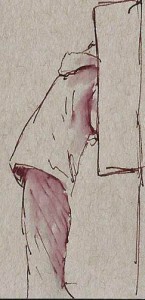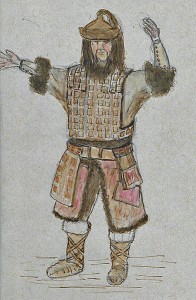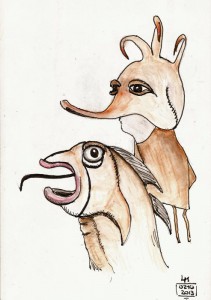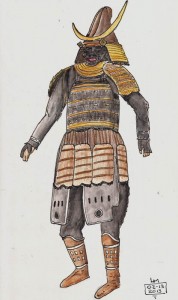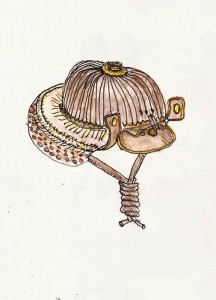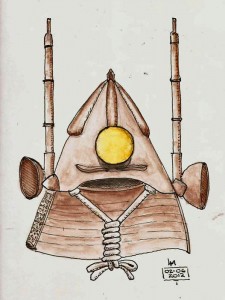Since I posted my review of the Pilot Metropolitan and talked about its use in recent posts, I’ve had several people ask me questions that all relate to the same thing: how does it compare to the Lamy Safari? I make no claims to doing exhaustive reviews of pens but I thought it might help some if I talked a bit about how I see the differences. Obviously I can’t do that objectively; every word of such a discussion is steeped with personal opinion. But maybe I can isolate some concepts and let you evaluate my biased analysis.
Esthetics and Feel
 While esthetics and feel are mostly personal parameters, it is safe to say that the Metropolitan is a cleaner, more traditional design. Some people complain about the triangular nature of the grip on the Lamy and while that’s not a problem for me, the Metropolitan grip is smooth and round. Both pens are quite tail heavy when posted and both long enough to write with comfortably without posting.
While esthetics and feel are mostly personal parameters, it is safe to say that the Metropolitan is a cleaner, more traditional design. Some people complain about the triangular nature of the grip on the Lamy and while that’s not a problem for me, the Metropolitan grip is smooth and round. Both pens are quite tail heavy when posted and both long enough to write with comfortably without posting.
The Safari offers more color choices, and availability of colors changes regularly. Lamy is about to release a flourescent yellow version which has me saying “WHAT are they thinking?” but some might like it. The Metropolitan comes in black, silver and gold, with some subtle trim choices.
The Lamy can be converted from cartridges using Lamy’s Z26 converter while the Pilot pen uses the CON-50. In my opinion, The Z26 is a bit nicer but as I fill all my pens using a pen syringe it doesn’t really matter to me. Any tube in a storm, to muck up a metaphor.
 The Safari is a fatter pen which may make a difference for those with small hands. The Metropolitan is made of brass while the Safari is plastic, though you can by Lamy’s All-Star if you want an aluminum pen.
The Safari is a fatter pen which may make a difference for those with small hands. The Metropolitan is made of brass while the Safari is plastic, though you can by Lamy’s All-Star if you want an aluminum pen.
One thing that might affect sketcher choices is that we like to turn our pens upside down to get a thinner line. Doing this with the Safari completely changes the feel of the pen, but not at all for the Metro.
I own three Lamy pens and only on Metropolitan but the Pilot nib seems smoother on papers I use.
Operation/Internals
Safari can be bought with a variety of nibs and it’s easy to buy and replace nibs so you can have one pen and swap out the nibs if you like. Metropolitans come in only medium, though from what I can see, Pilot also sells a Cocoon pen that seems identical to the Metropolitan but it’s available with a fine nib at more than twice the price of the Metropolitan. I don’t know why.
A quick word about nibs is in order. Lamy is a European manufacturer and uses a European sizing scale for its nibs. Pilot is an Asian company and uses an Asian scale. For any particular nib ‘name’ (eg – F), the Asian system will be finer than the European system. When comparing my XF Safari nibs to the M nib of the Metropolitan, I find that the Metropolitan M lays down a line just a tiny bit THINNER than my Safari XF pens. That said, my Lamys have been used a lot while the Metropolitan is fairly new. The Metropolitan is very near that of a Sakura Micron 02 if you’re familiar with those.
It’s a small thing but I find Lamy pens to be a bit more ‘sloppy’ when filling them by dipping into an ink bottle. They must be plunged deeper than Pilot pens. As I don’t do this at all I simply avoid the problem.
Misc
Lastly, the Pilot Metropolitan ($20) is cheaper than the Lamy Safari ($25). Thos prices are from Goulet Pens. Converters for them are about the same price. Safari has ubiquitous support; it’s every seller’s ‘beginner pen’. While Pilot pens are readily available, the sheer numbers of Lamy users gives ‘support’ to the Lamy pen.
If you have any questions about either of these pens, or any pen for that matter, I’d be happy to discuss it with you. I was a pen junky long before I became a sketcher. You can also see how these pens write (in the nib nook) and even buy them at Goulet Pens.
Conclusion
In the end, choosing a pen comes down to a bunch of personal preferences. For myself, I use a Pilot Prera (F) as my every day sketching pen. I like its fine line, smooth and flawless operation, and I like the fact that I can post the pen and, being short, the balance works out ‘just right.’ This is a bonus to me as a street sketcher as I don’t have to worry about losing the cap.
But lately the Pilot Metropolitan has become my pen of choice for quick-sketching people, something I’m doing a lot of lately because it’s so cold outside. Its slightly thicker line works better for this purpose and the fact that it’s inexpensive makes it a happy replacement for my Lamys, which remain in my arsenal but, by comparison, they’ve lost a bit of their charm for me. Well, except for my lime green Lamy which is the greatest color ever (grin).


